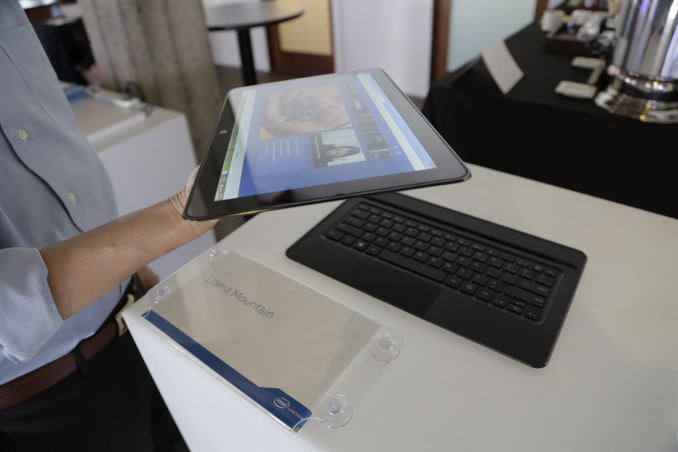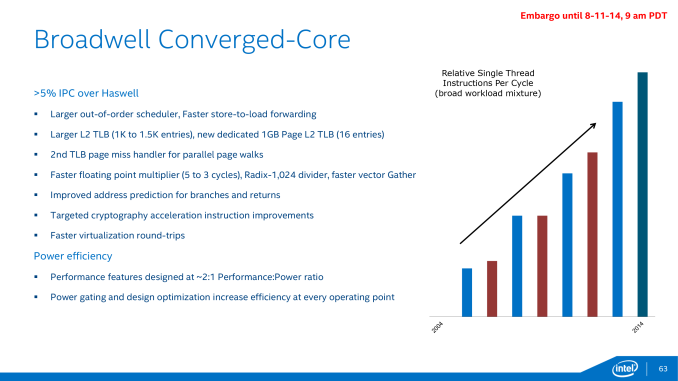Intel Broadwell Architecture Preview: A Glimpse into Core M
by Ryan Smith on August 11, 2014 12:01 PM ESTClosing Thoughts
Wrapping up our preview of the Broadwell architecture and Intel’s Core M processor, the bulk of Intel’s presentation and focus today is on the latter, so that is where we’ll start.
Core M is not a make-or-break product for Intel, but none the less it is a very important one. Mobile devices – be it tablets, slates, transformers, 2-in-1s etc – are continuing to increase in popularity, and as we’ve seen with ARM based tablets so far they form a market that has continued to grow and continued to erode the x86 laptop market that Intel has dominated for so long. Though laptops as a category are not going anywhere any time soon, their erosion means that Intel needs to get into mobile devices if they want to maintain their sales and their stature. To that end it’s not too late for Intel to break into this market and turn things around, but if they’re going to succeed then they need to make their move sooner or later, and this is where Core M fits in.
It’s telling then that while Intel is going after this market with a Core architecture, they are doing so under a different Core brand. Core M doesn’t just represent a new low powered Core CPU, but in Intel’s eyes is another product entirely. One that is so different that it does away with the Core i3/i5/i7 convention entirely and gets its own brand name and own product numbers. Core M is still Core, but it is nearly unrecognizable compared to the Core of even 4 years ago.
As far as the Core M product is concerned then, while Intel’s plans are grand they are not without merit. Backed by Intel’s new 14nm process and the Broadwell architecture, Core M looks like it should finally resolve the issues that dogged even Haswell-Y by bringing down power consumption even further while improving on Intel’s already strong performance, and getting the resulting processor in an SoC small enough to be usable in even the thinnest mobile devices. In fact from a technical perspective there’s little reason to doubt Core M; we’ll still have to wait to see just how good the resulting retail products are, but there shouldn’t be any technical reason for why it can’t be put into a mobile device comparable to today’s 10”+ tablets. Intel’s own Llama Mountain reference design can vouch for that much, showcasing the viability of Core M in a 12.5” tablet that’s just 7.2mm thick.
Intel's Llama Mountain, a Core M form factor reference design
More likely what will determine Core M’s fate and Intel’s ability to completely break into the mobile device market will be pricing. Intel’s profit margins are somewhat legendary in the computer industry, and a big part of that profitability has come from the high prices Intel has enjoyed from products such as their Core processors. Core M, like the other Cores before it, will still be an upscale product – a higher priced, higher performance alternative to Intel’s mass-market Atom processors. And while that makes plenty of sense on paper, in the real world Intel has to face the AllWinners and other ARM vendors of the world who are happy to sell their ARM SoCs at significantly lower margins, which can have a knock-on effect even if they can’t compete with Intel on overall performance. At this point it’s far too early to call this, especially when Intel isn’t even discussing Core M pricing at this time, but it’s a subject that Intel will have to consider carefully as “good enough” ARM devices will continue to be the biggest threat to Intel’s position in the CPU market.
Moving on, while today’s release from Intel only offers us a preview of what Intel will be delivering with their Broadwell architecture, what Intel has presented thus far looks to continue Intel’s tradition of relentless execution. As a tick Broadwell is a small but respectable improvement in Intel’s Core architecture, with the expected 5% IPC improvement in-line with previous ticks. For more traditional desktops and laptops it won’t radically change the world, but then it never was meant to. The biggest question for these parts will be whether Broadwell will improve on Haswell’s clockspeeds at all – a clockspeed boost made possible by Intel’s 14nm process – or if we’re going to hold steady similar to what we saw with the last tick, Ivy Bridge.
Meanwhile Broadwell’s GPU improvements are more significant, and in the race to further improve what’s essentially the baseline for PC GPU performance it is always welcome. Furthermore the fact that Intel is now at API feature parity with discrete GPUs is a big deal for Intel and it is a big deal for iGPUs as a whole. What we still want to see is more performance; a single slice seems just about right for Core M, but if we’re talking about larger laptop and desktop parts it would be very nice to see something akin to GT3 become baseline, especially with the die size savings Intel will be seeing from the 14nm process.
Finally, from here the rest of Intel’s 2014 should be rather busy. Next month is Intel’s Fall IDF 2014, at which point we expect we’ll be given a deeper look at Broadwell’s architecture. Past that the first Broadwell-Y based Core M processors will be on the shelves for the holidays, and with it our chance to see Broadwell and Intel’s 14nm process in action. However that will also be our only chance to see Broadwell in action this year; while Core M will ship in time for the holidays, the rest of the Broadwell lineup will not appear until 2015.













158 Comments
View All Comments
D. Lister - Saturday, August 30, 2014 - link
So you must be feeling pretty darn stupid now, realizing that you never had to buy the more expensive 3770K (plus the gtx680), since from your point of view it "feels" the same as an 8350 or an 8320 with an HD5850... eh? Here's an idea, sell your 3770K/GTX680 system, and buy an FX8320/HD5850... you would still get some of your money back - if you can't do that, then at least just shut the hell up and stop deliberately spreading misinformation, you unethical hypocrite.wintermute000 - Tuesday, August 12, 2014 - link
"well, an fx-8350 is toe-to-toe with an i7-2600k"You lost all credibility right there
wurizen - Tuesday, August 12, 2014 - link
no ididn't. u wish.wurizen - Tuesday, August 12, 2014 - link
u mean the credibility of anonymous internet opinions?rkrb79 - Tuesday, November 18, 2014 - link
Everyone can have their own opinions. Leave wurizen alone. Heaven forbid someone say something you don't agree with. Put on your big boy pants intel fanboys.tomsworkshop - Thursday, August 14, 2014 - link
Global Foundries was AMD spunoff fab, AMD still holding share on Global Foundries, Global Foundries are working tightly with Samsung fab right now for better manufacturing process, when they reach their goal in nm race they can compete with Intel in die shrink.FstEddie - Thursday, August 14, 2014 - link
Actually StevoLincolnite and others, you are quite confused. Using larger node sizes is not "cheaper to produce". Larger node sizes are more expensive per chip. The reason AMD (global foundries) does not just jump down to the next node is that it requires a great deal of capital up front (they are relatively broke) and R@D time which they are already behind on. Intel has proven more adept at shrinking process nodes and invests more in R&D ahead of time. This allows Intel to use the new node budget to partially increase performance, partially decrease power and partially decrease cost/chip. Cost per chip is the main driver for increasing density and depending on the generation Intel has re-balanced the performance/power/cost relationship.Samus - Wednesday, August 13, 2014 - link
I love what they did with the Z-height by embedding the chip "through" the motherboard PCB. That's really smart and will definitely improve thickness.beggerking@yahoo.com - Monday, August 11, 2014 - link
this looks to be very interesting... a true gaming windows 8.1/9 tablet laptop convertible in Surface Pro 3 form factor.A5 - Monday, August 11, 2014 - link
I'd hesitate to say that this will enable any kind of "real" gaming in the traditional sense. The iGPU isn't strong enough in this form factor, and AMD/NV draw too much power.